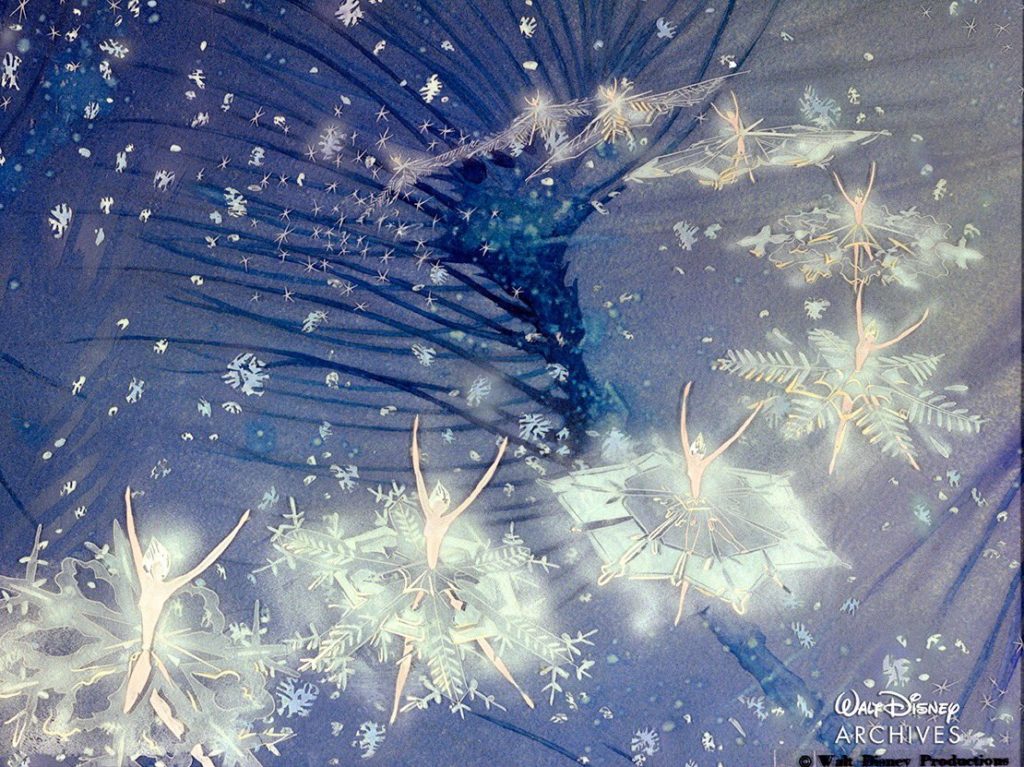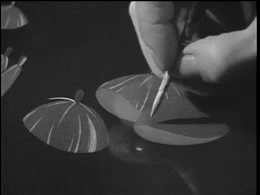Fall and Winter: stop motion and other experiments in Walt Disney’s Fantasia
Well, it’s around three o’clock on my blog’s clock, which for some reason is set on London time, and we’re approaching the moment when the oldest ladies would fall asleep. I am one of the oldest ladies. But I kept you company so far, and we’re missing just one pieces in our exploration of the […]
Well, it’s around three o’clock on my blog’s clock, which for some reason is set on London time, and we’re approaching the moment when the oldest ladies would fall asleep. I am one of the oldest ladies. But I kept you company so far, and we’re missing just one pieces in our exploration of the people and inspirations behind the most Christmassy piece of Walt Disney’s Fantasia: the Nutcracker. The piece we’re missing is the Waltz of the Flowers, which gets often confused with the Dance of the Reed Pipes (because the cartoon features dancing flowers), which in turn gets confused with the Marzipan dance and… yeah, I know.
Anyway, let’s get cracking.
3. The Nutcracker Piece by Piece (6)
We’re still in the Land of Sweets with the Prince and Clara, where all kinds of people are paying homage to the returning ruler. Except this piece is called the Dance of Flowers and flowers are not sweets.
3.6. Waltz of the Flowers: the music
In the original program, the dance is sometimes called Grand ballabile and follows the Dewdrop dance, sometimes omitted, and La mère Gigogne et les polichinelles. It precedes the Grand Pas de Deux which is pretty much the apex of the ballet (it’s the main act of the Sugar Plum Fairy, the prima ballerina), but it’s omitted from the suite.
Originally, it’s highly likely that flowers had a “sweet” connotation like everything else.
In The Life and Ballets of Lev Ivanov: Choreographer of The Nutcracker and Swan Lake, there’s a review of the first performance of The Nutcracker, which held place in December 1892 at the Imperial Mariinsky Theatre in Saint Petersburg. Within that review, the Waltz of Flowers is referred to as:
“The grand ballabile of the gilded sweetmeats”
Sweetmeats is a particular word for candied fruit. Gilded sweetmeats is an even stranger term, as it is well explained in this article I already used as reference for the Reed Flutes.
The dancers of that rendition were dressed in gold, so that‘s probably why the term is used. It is possible that the idea was to present sugared or candied flowers, which is something that used to be very popular for “edible” flowers like violets and roses. Candied violets in particular are still quite popular in Milan, my city, and they accompany Marron glaceés for what I can only assume is a chromatic reason. They are particularlypopular also in Toulouse, where the French of course took owership of them and called them violettes de Toulouse, but also in unsuspecting Derbyshire, where Swizzels Matlow manifactures their Parma Violets (nothing to do with the Italian city of Parma).

3.6. Waltz of the Flowers: the arrival of winter
If the whole Nutcracker Suite in Fantasia is set in a sort of fairy-tale sequence of seasons, this is where fall and winter take hold. We see seeds falling, in the shape of graceful ballerinas, autumn leaves carried by the wind, snowflakes start falling and frost fairies finish the job, bringing us back where we started. Nature falls asleep.

This final piece presented new technical challenges: animating a complex geometrical feature like a snowflake without altering its details was proving to be impossible, a work of precision that was unreasonable to require from any animator, even for a character such as the one of Walt Disney.
This story is told in several articles and books, particularly in John Canemaker’s Herman Schultheis and the Secrets of Walt Disney’s Movie Magic, in which the recollection goes as follows:
“To create this scene, Leonard Pickley, an inventive fellow in the Special Effects Department, started by suggesting that the Ink and Paint Department trace scientific diagrams of real snowflakes onto a material slightly heavier that regular cels and paint them in translucent white. Once cut out, each of the dozen or so snowflakes was secured atop revolving spools attached to small steel rails, like those used for Lionel toy trains. Black velvet covered the mechanics of the setup, and the three-dimensional snowflake models were hand-animated as the camera recorded the frame-by-frame progress down the hidden tracks.”
Leonard Pickley was tasked, with Gail Papineau, with what were being called Special camera effects, and if you want an idea of what does that mean I suggest you take a look at the full-length feature of The Reluctant Dragon, in which you get lots of interesting behind the scenes and insights on how they actually did stuff like this.

According to the They Drew as They Pleased series, another important artist was involced in the development of these snowflakes:
…model maker Wah Ming Chang, who had been hired in March 1939 by the Special Effects Department and worked on the gypsy wagon with Bob Jones, ended up developing the snowflakes that floated down in “The Nutcracker Suite” in Fantasia.
Wah Ming Chang was a Chinese-American designer, sculptor, and artist, who started working at a very young age with his adopted father James Blanding Sloan, an etcher, printmaker, theatrical designer, educator, painter, and puppeteer. Among the incredible stuff he did, he created sculptures and props for Star Trek: The Original Series, particularly the tricorder and communicator. His most famous work is, however, the headdress worn by Elizabeth Taylor in Cleopatra. The creation of the Snowflake fairies was carried out with colleague model-maker Henry Jones, whom he will work with also for the complex models of Bambi.
The fairies dancing in the middle of the snowflakes were hand drawn later and the final effect is a little weird but certainly avant-guarde.
“The result, is a dozen scenes, each timed to the music at a progressively faster pace, that bring a snowstorm of enchanting creatures to the screen in a luminous climax to the ‘Nutcracker Suite,’ one of Disney’s most beautiful film masterpieces.” (Canemaker)
The windblown seeds in the milkweed also required a special attention, as d23 tells us:
delicate inking, drybrush work (done with a brush whose bristles are dry, but can still hold paint), and airbrushing (similar to the effect of spray paint, and which required creating a mask (for each individual cel!) to keep certain areas free of paint).
Take a look at these astoishing animations for the process:
My absolute favourite characters however are the slender frost fairies, close relatives to the fairie that opened the Nutcracker segment and with which we opened tonight’s night of stories. They materialize from crystals in mid-air and proceed with movements of ballerinas and ice-skaters.
Ice-skating has been sort of an obsession, for Disney Animations, since the vert beginning and this is not the first time they tackle this challenge: the first one has to be the 1930 Silly Symphony Winter featured some animals ice-skating to a tune called “The Skater’s Waltz“.






One Comment